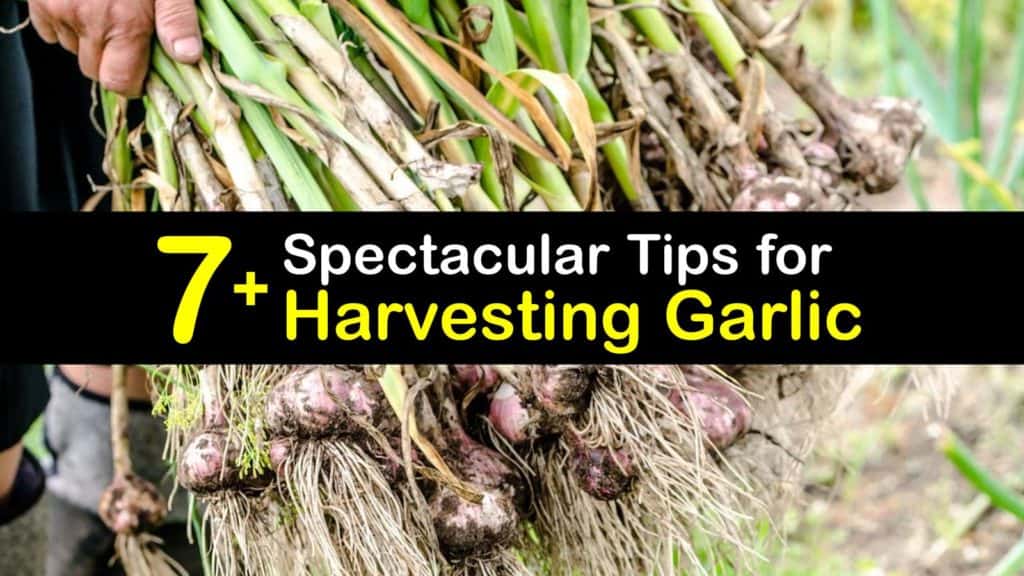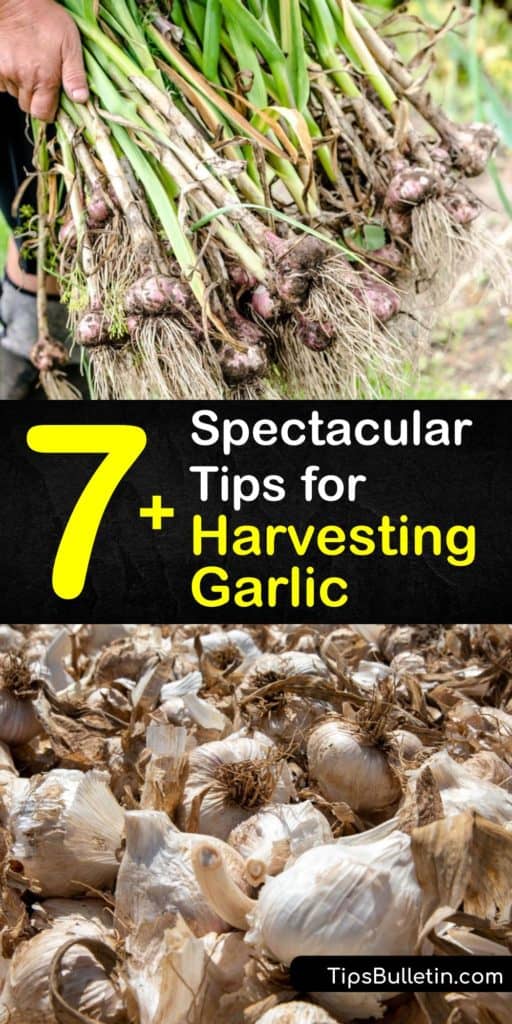So, you’ve opted to try growing garlic, and now you await the day when it’s ready for your kitchen. Unlike growing tomatoes or peppers, which are easy to notice when ripe, garlic is a whole different story. We explain when to harvest garlic, ways to cure and store it, and how to grow garlic greens from scraps.
This allium family plant is a must-have in every home with its ability to bring life to savory dishes. Raw garlic has a strong, pungent flavor, and cooking it changes the taste to mild and nutty.
Not only does this bulb enhance food, but it contains compounds with potent medicinal properties. With all the wonderful benefits they provide, it’s no wonder you decided to grow garlic in your garden.

When and How to Harvest Garlic
Unfortunately, knowing when garlic is mature and ready for harvesting is not as apparent as other vegetables. When are these aromatic bulbs ready to move from the ground to your dinner table?
While garlic cloves from the grocery store are readily available at any time of the year, fresh garlic from the garden is inexpensive and pesticide-free.
We discuss the different garlic varieties, when and how to harvest garlic, and give you some garlic storage tips.
What to Know Before Harvesting Garlic
When do you harvest garlic? When do you harvest beets? The answer depends on when you plant them. For garlic, it also depends on whether you grow hardneck or softneck varieties and whether you plant garlic in a container or the ground. Here are a few pieces of useful information to know before growing and harvesting garlic.
Garlic is related to leeks and onions, and there are softneck and hardneck varieties. There are a couple of differences between hardneck and softneck garlic.
The two main kinds of softneck garlic are artichoke and silverskin, and they are commonly sold in grocery stores.

Artichoke types have multiple layers covering about 20 cloves and are thick and hard to peel, with a shelf life of around eight months. Silverskin types have a high yield and adapt to many climates and are often seen in garlic braids.
Hardneck garlic grows flower stalks, or scapes, that contain bulbils, and there are several kinds, from German white and Rocambole to Persian star. These types often have bigger bulbs and are a good choice if you live in a colder climate.
Choosing from the different kinds of garlic may be the hardest part of growing this delicious plant.
When to Harvest Garlic
You’ve gone through the trouble of planting and nurturing your garlic plants and wait with anticipation for them to mature. The bulbs grow beneath the ground, so how do you tell when they are ripe and when is garlic ready to harvest?
Garlic Harvest Time
For fall planting, check your bulbs the following year between June and July. While this is the typical harvest time, it varies depending on where you live and which variety you plant. Softnecks tend to grow faster than hardnecks.
Inspect the green leaves or garlic scapes of your plants to determine if they are ready for harvesting. They are probably ready for digging when the lower leaves turn brown, but it’s sometimes necessary to pull up a bulb or two to make sure.
If the cloves fill the skin, they are mature. Do not leave the bulbs in the dirt too long to prevent individual cloves from separating and mold growth, and stop watering the plant once the leaves begin to decline.
How to Harvest Garlic
The day is finally here, and your plants have perfect garlic bulbs waiting for you to reveal them. The leaves are the right color, indicating that harvest time is now. Here is how to harvest garlic from your garden or raised beds.
The best time to dig up the mature bulbs is when the dirt is dry. The bulb size is considerably larger than the clove you planted, and these do not come out of the ground as easy as onions.
Loosen the dirt around the plant with a garden fork to dig up the garlic bulbs gently. Keep in mind while you work, they have a strong root system, and the bulb is several inches deep.
Shake the dirt from the garlic, place it into a basket, and move on to the next plant.
How Long Does Garlic Take to Grow?
How long does it take to grow garlic heads? Before harvesting garlic, it’s a good idea to know the growth rate of your bulbs. Unlike other veggies in the garden, garlic takes a lot more time to mature.
Growing your own garlic bulbs is a long process. While it’s easy to plant the cloves, waiting for them to mature often takes longer than new growers anticipate.
Growing garlic from seed takes about nine months, and planting them in the fall means you have to wait patiently until the middle of the next summer before you get to harvest them.
However, there is another way to grow garlic if you are too impatient. Green garlic is a good alternative since you harvest it after three or four months, and they are also useful for spring planting.
They have a milder taste, and you prepare them in recipes as you do mature garlic.
Common Problems to Watch for While Growing Garlic
Knowing how to harvest garlic is only part of the process of growing garlic. There are some things to watch for as you wait for the harvest to ensure that your plants remain healthy and strong.
Fungal disease is a common problem for garlic, and signs include premature yellowing of leaves and fluffy stem growth.
While there is nothing to remedy a current fungal problem, practicing crop rotation, widely spacing your plants for good air circulation, and removing mulch in the spring are excellent preventative measures.
Nematodes are tiny roundworms that live in dirt. Bloated leaves and a distressed-looking plant are signs that they are feeding on it. If you have an infested garden, the best course of action is to plant them in a new area to starve the worms out.
Mites feed on the roots and stem plates of both garlic and onions. A plant that is smaller than others around it with a weak root system is a sign of this pest. Crop rotation is the best remedy for this problem.
Taking advantage of the many garlic companion plants can stem problems before they start and provide benefits for other plants in your garden, as well.
Curing Garlic after You Harvest Bulbs
After harvesting garlic, it’s vital to cure the bulbs to prepare them for long-term storage. This process makes it possible for you to enjoy fresh garlic for many months without the fear of spoilage.
Start by shaking off excess dirt from each garlic bulb. Garlic must remain dry, so do not get them wet or wash them.
Bundle about ten garlic stems together and tie them with twine. Hang the bulbs upside down, in a dark, cool, dry place, such as the basement, for three to four weeks.
How to Store Garlic after Harvesting
A good garlic harvest means that it’s time for proper food storage. Fortunately, there are a few ways to store garlic short and long term. Here is how to store cured garlic in the kitchen and keep them in the refrigerator and freezer.
If you have softneck garlic, braid it together and hang it in an area of your home where the temperature is between 32 and 40°F, and there is proper air circulation.
Cut the bulbs off as needed and remove the papery skins before preparing. If you do not have a cool space, place the garlic in a ziplock bag and set it in the crisper drawer of your refrigerator.
Another great way to store garlic is to freeze it. Peel the paper off the bulb, separate the cloves and place them in a freezer bag. Press the air out and seal it shut before tossing it into the freezer.
Ways to Grow Garlic Greens from Scraps
If you discover that some of your garlic is sprouting, consider using these scraps for replanting garlic greens indoors or early spring planting outdoors. Green garlic is a young garlic plant, and the greens look a little like scallions.
Remove the outer skins and separate the garlic cloves. Fill a container with potting mix and make a hole about two inches deep.
To plant garlic, set the clove into the dirt with the pointy side up and fill in the area around it with soil. Pack it down lightly, give it some water, and set the pot in front of a sunny window.
Planting garlic in pots or the garden is relatively easy, but waiting for a garlic harvest takes a bit of patience. Understanding when the bulbs are mature and ready for harvest time is key to digging up healthy, flavorful garlic for adding to pesto or your favorite savory dish.

We hope that you enjoyed learning how and when to harvest garlic, and we’d love it if you’d share our garlic growing, harvesting, and storage guide with the garlic-lovers in your life on Facebook and Pinterest.